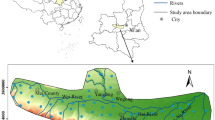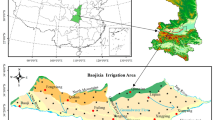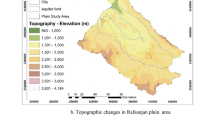Abstract
Groundwater is a significance source of freshwater in both urban and rural areas of the world. With the increasing groundwater pollution, it is essential to analysis of groundwater chemical characteristics and evaluate groundwater quality for water supply purpose. The study proposes basic water quality index module (BWQIM) and integrated water quality index module (IWQIM) by combining indictors, weights and model on water quality index (WQI)-based, and evaluated the groundwater quality in Chaoyang District, Beijing. The IWQIM and BWQIM were compared. Fe, HCO3−, TDS and TH were identified as key parameters of groundwater quality assessment. The water quality assessment results of BWQIM are scattered. However, the evaluation results of IWQIM are basically consistent and not influenced by indicators and weights. This module solves the problem that the weight of over standard indexes is submerged when multiple indexes are used, it is more reasonable and effective for groundwater quality evaluation, and overall situation of groundwater in the study area was concentrated in good level. Groundwater in aquifers in the study area is weakly alkaline. The Ca–HCO3 type characterized the general hydrogeochemical composition of Chaoyang district groundwater. Most samples fall in the rock dominance zone, suggesting that rock weathering and rock-water interactions are the primary sources controlling groundwater chemistry and hydrochemical evolution. These findings can provide an effective tool for the groundwater management for drinking and the sustainable development of water resources.







Similar content being viewed by others
References
Abdel-Fattah MK, Mokhtar A, Abdo AI (2021) Application of neural network and time series modeling to study the suitability of drain water quality for irrigation: a case study from Egypt. Environ Sci Pollut Res 28:898–914. https://doi.org/10.1007/s11356-020-10543-3
Adimalla N (2020a) Controlling factors and mechanism of groundwater quality variation in semiarid region of South India: an approach of water quality index (WQI) and health risk assessment (HRA). Environ Geochem Health 42:1725–1752. https://doi.org/10.1007/s10653-019-00374-8
Adimalla N (2020b) Spatial distribution, exposure, and potential health risk assessment from nitrate in drinking water from semi-arid region of South India. Hum Ecol Risk Assess Int J 26(2):310–334. https://doi.org/10.1080/10807039.2018.1508329
Adimalla N, Qian H (2021a) Groundwater chemistry, distribution and potential health risk appraisal of nitrate enriched groundwater: a case study from the semi-urban region of South India. Ecotoxicol Environ Saf 207:111277. https://doi.org/10.1016/j.ecoenv.2020.111277
Adimalla N, Qian H (2021b) Geospatial distribution and potential non-carcinogenic health risk assessment of nitrate contaminated groundwater in southern India: a case study. Arch Environ Contam Toxicol 80:107–119. https://doi.org/10.1007/s00244-020-00762-7
Adimalla N, Venkatayogi S (2018) Geochemical characterization and evaluation of groundwater suitability for domestic and agricultural utility in semi-arid region of Basara, Telangana State, South India. Appl Water Sci 8:44. https://doi.org/10.1007/s13201-018-0682-1
Ahmed S, Khurshid S, Madan R, Amarah B, Naushad M (2019) Water quality assessment of shallow aquifer based on Canadian council of ministers of the environment index and its impact on irrigation of Mathura district, Uttar Pradesh. J King Saud Univ 32:1218–1225. https://doi.org/10.1016/j.jksus.2019.11.019
Amiri V, Rezaei M, Sohrabi N (2014) Groundwater quality assessment using entropy weighted water quality index (EWQI) in Lenjanat Iran. Environ Earth Sci 72:3479–3490. https://doi.org/10.1007/s12665-014-3255-0
Asadi E, Isazadeh M, Samadianfard S, Ramli MF, Mosavi A, Nabipour N (2019) Groundwater quality assessment for sustainable drinking and irrigation. Sustainability 12(1):177. https://doi.org/10.3390/su12010177
Bidhuri S, Khan MMA (2020) Assessment of ground water quality of central and southeast districts of NCT of Delhi. J Geol Soc India 95:95–103. https://doi.org/10.1007/s12594-020-1390-7
Fulazzaky MA, Abdullah NH, Yusoff A, Paul E (2015) Conditioning the alternating aerobic–anoxic process to enhance the removal of inorganic nitrogen pollution from a municipal wastewater in France. J Clean Prod 100:195–201. https://doi.org/10.1016/j.jclepro.2015.03.043
Gao Y, Qian H, Ren W, Wang H, Liu F, Yang F (2020a) Hydrogeochemical characterization and quality assessment of groundwater based on integrated-weight water quality index in a concentrated urban area. J Clean Prod 260:121006. https://doi.org/10.1016/j.jclepro.2020.121006
Gao Y, Qian H, Wang H (2020b) Assessment of background levels and pollution sources for arsenic and fluoride in the phreatic and confined groundwater of Xi’an city, Shaanxi, China. Environ Sci Pollut Res 27:34702–34714. https://doi.org/10.1007/s11356-019-06791-7
Gibbs RJ (1970) Mechanisms controlling world water chemistry. Science 170:1088–1090. https://doi.org/10.1126/science.170.3962.1088
Hajji S, Ayed B, Riahi I et al (2018) Assessment and mapping groundwater quality using hybrid PCA-WQI model: case of the Middle Miocene aquifer of Hajeb Layoun-Jelma basin (Central Tunisia). Arab J Geosci 11:620. https://doi.org/10.1007/s12517-018-3924-5
Hao J, Zhang Y, Jia Y (2017) Assessing groundwater vulnerability and its inconsistency with groundwater quality, based on a modified DRASTIC model: a case study in Chaoyang District of Beijing City. Arab J Geosci 10:144. https://doi.org/10.1007/s12517-017-2885-4
Horton RK (1965) An index number system for rating water quality. J Water Pollut Control 37(3):300–306
House MA, Ellis JB (1987) The development of water quality indices for operational management. J Weed Sci Technol 19(9):145–154. https://doi.org/10.2166/wst.1987.0076
Huang Z, Zhao H, Dai L (2019) Beijing water resources bulletin. Beijing water authority. http://swj.beijing.gov.cn/zwgk/szygb. Accessed 26 Mar 2019
Jehan S, Ullah I, Khan S (2020) Evaluation of the Swat River, Northern Pakistan, water quality using multivariate statistical techniques and water quality index (WQI) model. Environ Sci Pollut Res 27:38545–38558. https://doi.org/10.1007/s11356-020-09688-y
Jha MK, Shekhar A, Jenifer MA (2020) Assessing groundwater quality for drinking water supply using hybrid fuzzy-GIS-based water quality index. Water Res 179:115867. https://doi.org/10.1016/j.watres.2020.115867
Kamrani S, Rezaei M, Amiri V (2016) Investigating the efficiency of information entropy and fuzzy theories to classification of groundwater samples for drinking purposes: Lenjanat Plain, Central Iran. Environ Earth Sci 75:1370. https://doi.org/10.1007/s12665-016-6185-1
Karunanidhi D, Aravinthasamy P, Subramani T (2021) Revealing drinking water quality issues and possible health risks based on water quality index (WQI) method in the Shanmuganadhi River basin of South India. Environ Geochem Health 43:931–948. https://doi.org/10.1007/s10653-020-00613-3
Logeshkumaran A, Magesh NS, Godson PS, Chandrasekar N (2015) Hydro-geochemistry and application of water quality index (WQI) for groundwater quality assessment, Anna Nagar, part of Chennai City, Tamil Nadu. India Appl Water Sci 5(4):335–343. https://doi.org/10.1007/s13201-014-0196-4
Lumb A, Sharma TC, Bibeault JF (2011) A Review of Genesis and Evolution of Water Quality Index (WQI) and Some Future Directions. Water Qual Expo Health 3:11–24. https://doi.org/10.1007/s12403-011-0040-0
Muzenda F, Masocha M, Misi SN (2019) Groundwater quality assessment using a water quality index and GIS: a case of Ushewokunze Settlement, Harare, Zimbabwe. Physics and chemistry of the earth. Parts a/b/c 112:134–140. https://doi.org/10.1016/j.pce.2019.02.011
Nong X, Shao D, Zhong H, Liang J (2020) Evaluation of water quality in the South-to-North Water Diversion Project of China using the water quality index (WQI) method. Water Res 178:115781. https://doi.org/10.1016/j.watres.2020.115781
Patil VBB, Pinto SM, Govindaraju T (2020) Multivariate statistics and water quality index (WQI) approach for geochemical assessment of groundwater quality-a case study of Kanavi Halla Sub-Basin, Belagavi, India. Environ Geochem Health 42:2667–2684. https://doi.org/10.1007/s10653-019-00500-6
Piper A (1994) A graphic procedure in the geochemical interpretation of water analyses. Eos Trans Am Geophys 25:914–928. https://doi.org/10.1029/TR025i006p00914
Rajankar PN, Gulhane SR, Tambekar DH, Ramteke DS, Wate SR (2009) Water quality assessment of groundwater resources in Nagpur Region (India) based on WQI. E-J Chem 6(3):905–908. https://doi.org/10.1155/2009/971242
Rao KN, Latha PS (2019) Groundwater quality assessment using water quality index with a special focus on vulnerable tribal region of Eastern Ghats hard rock terrain, Southern India. Arab J Geosci 12:267. https://doi.org/10.1007/s12517-019-4440-y
Shaefer DJ, Janardan KG (1977) Communicating environmental information to the public a new water quality index. J Environ Educ 8:18–26
Shannon CE (1948) A mathematical theory of communication. Bell Syst Tech J 27:379–423. https://doi.org/10.1002/j.1538-7305.1948.tb01338.x
Talib MA, Tang Z, Shahab A, Siddique J, Faheem M, Fatima M (2019) Hydrogeochemical characterization and suitability assessment of groundwater: a case study in Central Sindh, Pakistan. Int J Environ Res Public Health 16(5):886. https://doi.org/10.3390/ijerph16050886
Ustaoğlu F, Tepe Y, Taş B (2020) Assessment of stream quality and health risk in a subtropical Turkey river system: a combined approach using statistical analysis and water quality index. Ecol Ind 113:105815. https://doi.org/10.1016/j.ecolind.2019.105815
Vaiphei SP, Kurakalva RM, Sahadevan DK (2020) Water quality index and GIS-based technique for assessment of groundwater quality in Wanaparthy watershed, Telangana, India. Environ Sci Pollut Res 27:45041–45062. https://doi.org/10.1007/s11356-020-10345-7
Wang G, Fang Q, Teng Y, Yu J (2016) Determination of the factors governing soil erodibility using hyperspectral visible and near-infrared reflectance spectroscopy. Int J Appl Earth Obs Geoinf 53:48–63. https://doi.org/10.1016/j.jag.2016.08.006
Wang G, Li J, Sun W, Xue B, A Y, Liu T, (2019a) Non-point source pollution risks in a drinking water protection zone based on remote sensing data embedded within a nutrient budget model. Water Res 157:238–246. https://doi.org/10.1016/j.watres.2019.03.070
Wang P, Yao J, Wang G, Hao F, Shrestha S, Xue B (2019b) Exploring the application of artificial intelligence technology for identification of water pollution characteristics and tracing the source of water quality pollutants. Sci Total Environ 693:133440. https://doi.org/10.1016/j.scitotenv.2019.07.246
WHO (2011) World Health Organisation, Guidelines for drinking water quality, WHO chronicle 92(4):154815-1
Xu P, Li M, Qian H (2019a) Hydrochemistry and geothermometry of geothermal water in the central Guanzhong Basin, China: a case study in Xi’an. Environ Earth Sci 78:87. https://doi.org/10.1007/s12665-019-8099-1
Xu P, Zhang Q, Qian H (2019b) Characterization of geothermal water in the piedmont region of Qinling Mountains and Lantian-Bahe Group in Guanzhong Basin. China Environ Earth Sci 78:442. https://doi.org/10.1007/s12665-019-8418-6
Xu P, Zhang Q, Qian H, Li M, Yang F (2021a) An investigation into the relationship between saturated permeability and microstructure of remolded loess: a case study from Chinese Loess Plateau. Geoderma 382:114774. https://doi.org/10.1016/j.geoderma.2020.114774
Xu P, Zhang QY, Qian H, Yang FX, Zheng L (2021b) Investigating the mechanism of pH effect on saturated permeability of remolded loess. Eng Geol 284:0013–7952. https://doi.org/10.1016/j.enggeo.2020.105978
Xue B, Wang G, Xiao J, Helman D, Sun W, Wang J (2020) Global convergence but regional disparity in the hydrological resilience of ecosystems and watersheds to drought. J Hydrol 591:125589. https://doi.org/10.1016/j.jhydrol.2020.125589
YinglanWang AG, Liu T, Xue B, Kuczera G (2019) Spatial variation of correlations between vertical soil water and evapotranspiration and their controlling factors in a semi-arid region. J Hydrol 574:53–63. https://doi.org/10.1016/j.jhydrol.2019.04.023
Zhai Y, Lei Y, Zhou J (2015) The spatial and seasonal variability of the groundwater chemistry and quality in the exploited aquifer in the Daxing District, Beijing, China. Environ Monit Assess 187:43. https://doi.org/10.1007/s10661-014-4249-9
Zhang X, Sun M, Wang N, Huo Z, Huang G (2016) Risk assessment of shallow groundwater contamination under irrigation and fertilization conditions. Environ Earth Sci 75:603. https://doi.org/10.1007/s12665-016-5379-x
Zhang QY, Xu PP, Qian H, Yang FX (2020a) Hydrogeochemistry and fluoride contamination in Jiaokou Irrigation District, Central China: assessment based on multivariate statistical approach and human health risk. Sci Total Environ 741:140460. https://doi.org/10.1016/j.scitotenv.2020.140460
Zhang QY, Xu PP, Qian H (2020b) Groundwater quality assessment using improved Water Quality Index (WQI) and Human Health Risk (HHR) evaluation in a semi-arid region of Northwest China. Expo Health 12:487–500. https://doi.org/10.1007/s12403-020-00345-w
Zhang QY, Qian H, Xu PP, Li WQ, Feng WW, Liu R (2021) Effect of hydrogeological conditions on groundwater nitrate pollution and human health risk assessment of nitrate in Jiaokou Irrigation District. J Clean Prod 298:126783. https://doi.org/10.1016/j.jclepro.2021.126783
Acknowledgements
This study was financially supported by Research on key technology of water quality safety in underground hydraulic Mining and restoration in Miyun District, Beijing (2018000020124G037). This study was financially supported by the study on the watershed water management system of the Sino-German cooperation project of Hebei Institute of Water Science. This research was financially supported by the Beijing Advanced Innovation Program for Land Surface Science. The authors would like to thank the editor and anonymous reviewers for their valuable comments that greatly improved the work.
Funding
This study was funded by Research on key technology of water quality safety in underground hydraulic Mining and restoration in Miyun District, Beijing (2018000020124G037).
Author information
Authors and Affiliations
Contributions
YZ: conceptualization, formal analysis, funding acquisition, supervision. RJ: methodology, data curation, software, writing-original draft, writing-review. JW: methodology, writing—review and editing. WQ: formal analysis, supervision, editing. ZL: data curation, investigation.
Corresponding author
Ethics declarations
Conflict of interest
We declare that all authors have no any actual or potential conflict of interest including and financial, personal or other relationships with other people or organizations.
Additional information
Publisher's Note
Springer Nature remains neutral with regard to jurisdictional claims in published maps and institutional affiliations.
This article is part of a Topical Collection in Environmental Earth Sciences on Groundwater quality and contamination and the application of GIS, guest edited by Narsimha Adimalla and Hui Qian.
Supplementary Information
Below is the link to the electronic supplementary material.
Rights and permissions
About this article
Cite this article
Zhang, Y., Jia, R., Wu, J. et al. Uncertain in WQI-based groundwater quality assessment methods: a case study in east of Beijing, China. Environ Earth Sci 81, 202 (2022). https://doi.org/10.1007/s12665-022-10311-1
Received:
Accepted:
Published:
DOI: https://doi.org/10.1007/s12665-022-10311-1




